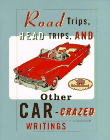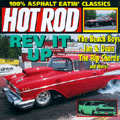|
|
|
||
 |
|||
|
|
|||
|
TNN Sportsí coverage, and its Aug. 13 showing of the IHRA Holley Spring Nationals at Rockingham Dragway, was their second presentation of the season in conjunction with the Norwalk, Ohio-based association. I didnít see the IHRA Winter Nationals program that debuted the TNN/IHRA 2000 TV package on Aug. 6, but if it was anything like the Rockingham coverage, I certainly didnít feel rained on, mainly because I think Iíve seen it all before. Certainly not the specifics of the race, but the coverage type was old hat. If one sees the IHRA national events like drag racing used to be 10-15 years ago (and thatís not a knock), then I would say that the TV coverage dovetailed nicely with that ambiance. All the standard camera angles were used; three-quarter rear, fender-to-fender at the line, head-on from the center in front of the Tree; half-track camera, and parachute shots. The obligatory winner interviews were in act as well as a few human interest spots and three or four 20-30 second tech explanations. No new ground being broken. If there was anything that differed from, say NHRAís coverage (other than length) it was the avoidance of the up-the-nose of the Top Fuel dragster camera pans and very low visibility for announcers Ralph Shaheen, Tommy Johnson Jr., and Aaron Polborn. To TNN and IHRAís credit, they didnít slavishly copy NHRAís pep rally, interview-heavy presentation (mainly because NHRAís coverage is live-er) but crammed in as much action in as possible. IHRA also broke from the norm by presenting each of their top-drawer eliminators as a separate entity. They started with Pro Modified and gave you that eliminator to the finish. Then they went to Funny Car, Pro Stock, Nitro Harley and on to Top Fuel. They also, for whatever reason, chose to refer to the on-screen eliminator ladder as "brackets," which Ö well, I donít know why the hell they did that. For the most part, you create new verbiage to improve communication, but for, at least veteran watchers, it seemed like mere fluff. Overall, I thought the separate eliminator approach was a pretty good move given that the Rockingham race (originally hosted April 7-9) was four months old and, given that time lapse, had zero news value. Any attempt to present this as a live national event with breathless, late-breaking on-the-spot coverage wouldíve drawn laughter and beer bottles bouncing off the screen. And this brings up a big problem with the IHRA shows. The national events are old news ó very old news. If IHRA is merely using the 2000 season as a showcase for their association by showing the viewer what they can expect at one of their events, then the time question is understandable in that light. Or if itís used as bait to entice new viewers then that would be all right. Anything else, though, is strictly fodder for hardcore fans who would watch a half hour of clutch sanding or chrome polishing. And so far, courting the hardcore hasnít paid off in stadium suite dividends. I donít know what I expected when I tuned in the IHRA show Sunday night, but there was nothing on it I hadnít seen before. Oh sure, Johnny Mancusoís wild Nitro Harley ride in the semi-finals or Pro Stock racer Steve Spiessí top-end rollover, but other than that, drag racing TV business as usual. And frankly, Iím stumped on this drag racing television business as usual. The simple fact remains that attending a championship drag race beats the hell out of watching one on TV. Yet, drag racing needs TV to buff the sponsors and sell the races, and so far, theyíve been doing a C+ job on the tube. With ultra rare exceptions, the drags just donít transfer over to TV. So whaddaya make of it? I guess seemingly unsolvable mysteries like TV and drag racing are why companies like Maalox and Pepto Bismol continue to make the fat ass bucks.
|
|||
|
Copyright 1999-2001, Drag Racing Online and Racing Net Source |
|||





